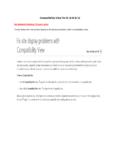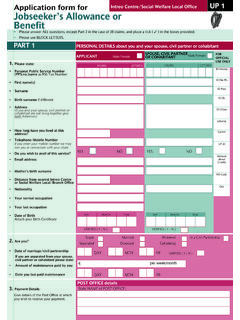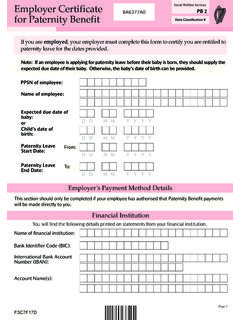Transcription of guide to chalkline - Jane Mitchell
1 This novel has been chosen for use in the senior classes of primary school and the junior classes of sec-ondary school because it deals in a compelling and sensitive manner with themes such as human rights, armed conflict, and gender equal-ity, all of which are relevant in the contemporary world. chalkline is on the Junior Certificate curriculum for English and its subject matter is highly relevant today in light of recent events in places such as Syria, Palestine and Iraq, and in view of the current challenges faced by children living in areas of armed conflict. The subject matter of the story pro-vides plenty of opportunity for dis-cussion, activities, debate and the development of personal opinion. Themes are explored in a way that is powerful and compelling, resonating with clarity.
2 The main discussion areas woven into the fabric of the story include: Children and armed conflict Death and loss Human Rights Education Gender equality Family and friendship Rafiq is only nine when Kashmiri Freedom Fighters raid his village in search of new recruits. Tall for his age, he is the first boy to cross the chalk line into a life of brutality and violence. Jameela cannot forget her brother. While Rafiq is trained to kill in the rebel camp high in the mountains, she keeps his memory alive. When finally their paths cross again, Rafiq is unrecognisable as the boy who left the village. Will Jameela know him? About the story chalkline by Jane Mitchell Teaching guide J A N E M I T C H E L L | A W A R D W I N N I N G W R I T E R O F B O O K S F O R C H I L D R E N A N D Y O U N G A D U L T S E M A I L : J A N E @ J A N E M I T C H E L L.
3 I E T W I T T E R : @ J M I T C H E L L W R I T E R Rationale and Themes About the cover The cover of chalkline shows the boy Rafiq against his school wall, with a chalk line at his ear. Illustrators often use symbols to represent ideas and meanings. What do you think the images in the background mean? What might they symbolise? Design your own cover for the book. Try to include symbolism to represent ideas and meanings from the story. Amnesty International This book has been endorsed by Amnesty In-ternational as contributing to a better under-standing of human rights and the values that underpin them. This means that Amnesty rec-ommends it. Find out more about Amnesty from their website: About the author Jane Mitchell is one of Ireland s leading authors for children and young adults. She has published seven novels several of which are award-winners and three short stories.
4 In 1994, her debut novel When Stars Stop Spin-ning won Ireland s premier youth literature award: CBI Bisto Book of the Year Award. chalkline won the inaugural CBI Children s Choice Award in 2010. Jane lives in Dublin and works in an NGO providing services for people with disabilities. You can find out more about Jane at P A G E 2 Prologue Fourteen year-old Rafiq leads a team of children as they ambush an armed convoy high in the mountains of Kashmir, north India. Rafiq is a hard taskmaster, using every oppor-tunity to tutor the younger boys in the skills they need to ambush suc-cessfully. They are nervous of him, which hints at Rafiq s tougher side. The ambush is successful and the boys escape into the hills with their plunder. Chapter 1 Five years earlier and back in their small village in the mountains, seven year-old Jameela is sent by her mother to call her brothers Rafiq and Mahmood for their dinner.
5 Jameela takes her sibling, baby Im-raan and toddler Afrah, to find the boys, who are not happy to be called in by their sister. After dinner, Rafiq teaches his little sister to read: girls do not go to school in their village. Their father believes it is a waste of time, but their mother thinks it is important. Rafiq wants to be a teacher when he grows up, and to have girls as well as boys in his class. Chapter 2 Early the next morning, gunmen storm into Rafiq s school, terrifying the children and teachers with vio-lence and gunfire. They draw a chalk line on the wall of the classroom and measure every boy against it. Rafiq is the first child who is taller than the chalk line and is thrown into a truck, along with almost half the boys from the school. To the bewil-derment of the children, the gunmen slam shut the truck door and drive out of the village.
6 Chapter 3 The truck travels for many hours. It is hot and uncomfortable inside. The gunmen stop to eat and rest in the fresh air for a while. Rafiq is ashamed of some of the boys, who cry openly. He remembers when he got lost as a small child and his fa-ther told him never to shame his family by showing his emotions. When the boys have to return to the truck, one boy escapes, only to be gunned down by the gunmen, which shocks the other boys. Chapter 4 Back in the village, the teachers and small boys left behind in the school tell the villagers what has happened. Jameela, her mother and younger siblings hear the terrible news. There is an outpouring of grief and anger from the villagers. The village men head off with makeshift weap-ons to look for the boys, but return hours later in desolation, not having found anything.
7 Chapter 5 Rafiq and the boys travel for a long time in the truck. When they stop, it is night-time. They are tied in a long line by the gunmen and made to march through the night and finally rest beneath a huge banyan tree. Rafiq is exhausted but cannot sleep as thinks of his family and Jameela. Only the previous evening, he had shown her the new kid goat that had just been born, not realising how much his life would change. Chapter 6 On the third day after his capture, the boys are led high into the moun-tains where the temperature drops. Rafiq is impatient with the weaker boys who constantly fall. One of the gunmen recognises Rafiq s strong spirit and potential. The boys are untied to climb over a dangerous ravine and Rafiq almost falls, but manages to clamber across. That evening, they arrive at a camp set-tlement nestled deep in the moun-tains: their final destination.
8 Unit 1: Prologue and Chapters 1 to 6 (pages 7-68) J A N E M I T C H E L L 2 0 1 7 | W W W . J A N E M I T C H E L L . I E Unit 1 Discussion Points In the Prologue, Rafiq teaches Omar and Tariq to lay mines on the road. Their hands shake and they are nervous. Why might they be afraid? Does Rafiq make it harder for them or is he suppor-tive? Explain your answers. In Chapter 1, we find out that Jameela doesn t go to school. She relies on Rafiq to teach her to read. This is not unusual. In many countries around the world, girls have no right to education. Do you agree with this? Why/why not? Should all girls have a right to education? Why do some countries have different views on this? Give reasons for your answers. In Chapter 4, Jameela is in the village square with her mother, Mahmood, Afrah and Imraan when she learns about what happened to Rafiq.
9 Should the children have heard the truth? How do you think that difficult news should be given to children? Summary of prologue & chapters 1 to 6 Teaching guide approach For the purposes of this teaching guide , the novel has been divided into four units, loosely based on the structure of the story. Chapter summaries, discussion points and activities, mostly based on language development, are included for each unit. The pace at which the novel is read depends on the teacher and the students. What is a child soldier? Any person under 18 years of age who is recruited or used by an armed group in any capacity, includ-ing boys and girls used as fighters, cooks, porters, messengers, spies or for sexual purposes. Chapter 7 In the settlement, the boys are given food. Rafiq does not want to be there.
10 He thinks of his family and vil-lage, and silently objects when the lead gunman, Ab-dullah, refers to the settlement as Rafiq s new home and the people as his new family. The boys are brought to the river to wash, and after prayers, are locked in huts to sleep. For the first time since his capture, Rafiq gives in to his grief. Tears spill down his cheeks as one of the gunmen guards them. Chapter 8 It is still dark when the boys are sent to collect fuel and water the following morning, beaten by Abdullah and another gunman, Kareem. After washing and praying, the boys are marched to an assault course in the mountains. Rafiq throws stones at a weak slow boy, and the other boys copy him. They must compete against each other for water. Rafiq succeeds in getting a bottle of water but is ambushed by another boy who steals his prize.






